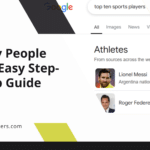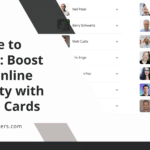
|
Getting your Trinity Audio player ready...
|
In today’s digital age, having a strong online presence is crucial for bloggers. With millions of blogs competing for attention, it can be challenging to stand out from the crowd. This is where search engine optimization (SEO) comes into play. SEO is the practice of optimizing your website and its content to rank higher in search engine results pages (SERPs). By implementing SEO strategies, bloggers can increase their visibility, attract more organic traffic, and ultimately grow their audience.
Key Takeaways
- SEO is the process of optimizing your website to rank higher in search engine results pages.
- Keyword research helps you identify the words and phrases your target audience is searching for.
- Compelling headlines and meta descriptions can improve click-through rates and attract more traffic to your blog post.
- Incorporating keywords throughout your blog post can help search engines understand the topic of your content.
- Formatting your blog post for readability and SEO includes using headings, bullet points, and short paragraphs.
Understanding the Basics of SEO
SEO stands for search engine optimization. It is the process of optimizing your website and its content to improve its visibility in search engine results pages (SERPs). When someone searches for a specific keyword or phrase, search engines like Google use complex algorithms to determine which websites are most relevant to that query. By optimizing your website and its content, you can increase your chances of ranking higher in these search results.
For bloggers, SEO is essential because it helps drive organic traffic to their websites. Organic traffic refers to visitors who find your website through a search engine rather than through paid advertising or other means. By ranking higher in search results, you can attract more organic traffic and increase your chances of converting visitors into loyal readers or customers.
To understand how SEO works, it’s important to have a basic understanding of how search engines operate. Search engines use bots called crawlers or spiders to discover and index web pages. These crawlers follow links from one page to another, collecting information about each page they visit. This information is then stored in a massive database called an index.
When someone performs a search, the search engine uses its algorithm to determine which pages in its index are most relevant to that query. The algorithm takes into account various factors such as keyword usage, page load speed, mobile-friendliness, and user experience. The pages that are deemed most relevant are then displayed in the search results.
Conducting Keyword Research for Your Blog Posts
Keyword research is a crucial step in the SEO process. It involves identifying the keywords and phrases that your target audience is using to search for information related to your blog post topic. By incorporating these keywords into your content, you can increase your chances of ranking higher in search results and attracting more organic traffic.
There are several tools available for conducting keyword research. One popular tool is Google Keyword Planner, which provides insights into the search volume and competition for specific keywords. Other tools like SEMrush and Moz Keyword Explorer can also help you identify relevant keywords and analyze their performance.
When choosing keywords for your blog post, it’s important to consider both search volume and competition. High search volume indicates that a lot of people are searching for that keyword, but it also means there will be more competition. On the other hand, low competition means there are fewer websites targeting that keyword, but it may also indicate lower search volume. It’s important to strike a balance between search volume and competition to find the right keywords for your blog post.
Crafting Compelling Headlines and Meta Descriptions
| Metrics | Description |
|---|---|
| Click-Through Rate (CTR) | The percentage of people who click on your headline and visit your website. |
| Keyword Relevance | The extent to which your headline and meta description match the user’s search query. |
| Length | The number of characters in your headline and meta description. It’s important to keep them within the recommended limits to avoid truncation. |
| Emotional Appeal | The ability of your headline to evoke emotions and connect with your audience. |
| Uniqueness | The extent to which your headline stands out from the competition and offers a unique value proposition. |
| Brand Awareness | The ability of your headline and meta description to reinforce your brand identity and increase brand recognition. |
Headlines and meta descriptions play a crucial role in SEO. They are the first thing users see when your blog post appears in search results, so they need to be compelling and informative. A well-crafted headline can entice users to click on your link, while a well-written meta description can provide a concise summary of your content.
When crafting headlines, it’s important to include relevant keywords while still making them engaging and attention-grabbing. Avoid using clickbait tactics or misleading headlines, as this can lead to high bounce rates and damage your website’s reputation. Instead, focus on creating headlines that accurately reflect the content of your blog post and pique the reader’s curiosity.
Meta descriptions should provide a brief summary of your blog post and include relevant keywords. They should be concise, informative, and compelling. Aim for a meta description length of around 150-160 characters to ensure that it is displayed in its entirety in search results.
Here are some examples of effective headlines and meta descriptions:
Headline: “10 Tips for Writing Engaging Blog Posts That Keep Readers Coming Back for More”
Meta Description: “Learn how to write blog posts that captivate your audience and keep them coming back for more. These 10 tips will help you create engaging content that drives traffic and boosts your online presence.”
Headline: “The Ultimate Guide to SEO for Bloggers: Boost Your Organic Traffic and Grow Your Audience”
Meta Description: “Discover the secrets to optimizing your blog for search engines and attracting more organic traffic. This comprehensive guide covers everything you need to know about SEO for bloggers.”
Incorporating Keywords Throughout Your Blog Post
Once you have identified the keywords you want to target, it’s important to incorporate them naturally throughout your blog post. This helps search engines understand what your content is about and improves your chances of ranking higher in search results.
Keyword density refers to the percentage of times a keyword appears in relation to the total number of words in a piece of content. While there is no specific keyword density that guarantees better rankings, it’s generally recommended to aim for a keyword density of around 1-2%. This means that for every 100 words, your keyword should appear 1-2 times.
When incorporating keywords into your blog post, it’s important to do so in a way that feels natural and doesn’t disrupt the flow of your content. Avoid keyword stuffing, which is the practice of overusing keywords in an attempt to manipulate search engine rankings. This can result in penalties from search engines and harm your website’s visibility.
Here are some examples of effective keyword usage:
– Use keywords in your blog post title and headings.
– Include keywords in the first paragraph of your blog post.
– Sprinkle keywords throughout the body of your content, but only where it makes sense to do so.
– Use variations of your keywords to make your content more diverse and natural.
Formatting Your Blog Post for Readability and SEO
Formatting your blog post is not only important for readability but also for SEO. Search engines take into account factors such as headings, subheadings, bullet points, and bold or italicized text when determining the relevance and structure of your content.
To optimize your blog post for readability and SEO, consider the following tips:
– Use headings and subheadings to break up your content and make it easier to read.
– Use bullet points or numbered lists to organize information and make it more scannable.
– Bold or italicize important keywords or phrases to draw attention to them.
– Use short paragraphs and sentences to improve readability.
– Include relevant images or videos to enhance your content and engage readers.
By formatting your blog post in a way that is both visually appealing and easy to read, you can improve the user experience and increase the likelihood of visitors staying on your page longer.
Including Internal and External Links
Internal and external links are an important aspect of SEO. Internal links are links that point to other pages within your website, while external links are links that point to other websites. Including these links in your blog post can help search engines understand the structure of your website and improve its visibility in search results.
Internal links help search engines discover new pages on your website and establish a hierarchy of importance. They also help users navigate your website and find related content. When including internal links, make sure they are relevant to the topic of your blog post and provide additional value to the reader.
External links, on the other hand, can help establish the credibility and authority of your website. By linking to reputable sources, you show search engines that you have done thorough research and provide valuable information to your readers. When including external links, make sure they are from trusted sources and add value to your content.
Here are some tips for including links in your blog post:
– Include at least one internal link and one external link in each blog post.
– Use descriptive anchor text for your links. Instead of using generic phrases like “click here,” use keywords or phrases that accurately describe the content of the linked page.
– Avoid overusing links. Only include links when they provide additional value to the reader.
– Regularly review and update your internal and external links to ensure they are still relevant and working properly.
Optimizing Images for SEO
Images play a crucial role in engaging readers and enhancing the visual appeal of your blog post. However, they can also impact your website’s SEO if not optimized properly. By optimizing your images for SEO, you can improve their visibility in image search results and attract more organic traffic.
When optimizing images for SEO, consider the following tips:
– Use descriptive file names for your images. Instead of using generic names like “image1.jpg,” use keywords or phrases that accurately describe the content of the image.
– Compress your images to reduce file size and improve page load speed. Slow-loading pages can negatively impact user experience and search engine rankings.
– Add alt text to your images. Alt text is a brief description of an image that is displayed when the image cannot be loaded. It helps search engines understand what the image is about and improves accessibility for visually impaired users.
– Use captions for your images when appropriate. Captions can provide additional context and improve user engagement.
By optimizing your images for SEO, you can improve the overall user experience and increase the likelihood of visitors staying on your page longer.
Utilizing Social Media to Promote Your Blog Post
Social media is a powerful tool for promoting your blog post and driving traffic to your website. With billions of active users on platforms like Facebook, Instagram, Twitter, and LinkedIn, social media provides a vast audience for bloggers to reach.
When promoting your blog post on social media, consider the following tips:
– Share your blog post on multiple social media platforms to reach a wider audience.
– Craft compelling and engaging captions that entice users to click on your link.
– Use relevant hashtags to increase the visibility of your posts.
– Engage with your audience by responding to comments and messages.
– Share snippets or teasers of your blog post to generate curiosity and encourage users to click on your link.
By utilizing social media to promote your blog post, you can increase its visibility, attract more organic traffic, and grow your audience.
Monitoring and Analyzing Your Blog Post’s Performance
Monitoring and analyzing your blog post’s performance is crucial for understanding what is working and what needs improvement. By tracking key metrics such as page views, bounce rate, time on page, and conversion rate, you can gain valuable insights into how users are interacting with your content.
There are several tools available for monitoring and analyzing your blog post’s performance. Google Analytics is one of the most popular tools and provides comprehensive data on website traffic, user behavior, and conversions. Other tools like SEMrush and Moz also offer analytics features that can help you track the performance of your blog post.
When analyzing your blog post’s performance, consider the following tips:
– Identify trends and patterns in user behavior. Are there certain topics or formats that perform better than others?
– Look for opportunities to optimize your content. Are there keywords or phrases that you could target more effectively?
– Identify areas for improvement. Are there pages with high bounce rates or low conversion rates that need attention?
– Use data to inform future content creation. What topics or formats resonate most with your audience?
By monitoring and analyzing your blog post’s performance, you can make data-driven decisions to improve your content and drive better results.
Staying Up-to-Date with SEO Best Practices and Algorithm Updates
SEO is an ever-evolving field, with search engines constantly updating their algorithms to provide the best possible user experience. It’s important for bloggers to stay up-to-date with the latest SEO best practices and algorithm updates to ensure their content remains relevant and visible in search results.
To stay up-to-date with SEO best practices and algorithm updates, consider the following tips:
– Follow reputable SEO blogs and websites for the latest news and insights.
– Attend industry conferences and webinars to learn from experts in the field.
– Join online communities or forums where you can discuss SEO topics with other bloggers and professionals.
– Experiment with different strategies and techniques to see what works best for your website.
– Regularly review and update your content to ensure it remains relevant and optimized.
By staying up-to-date with SEO best practices and algorithm updates, you can ensure that your blog posts are optimized for maximum visibility and organic traffic.
In conclusion, SEO is a crucial aspect of blogging that can help increase your visibility, attract more organic traffic, and grow your audience. By understanding the basics of SEO, conducting keyword research, crafting compelling headlines and meta descriptions, incorporating keywords throughout your blog post, formatting your blog post for readability and SEO, including internal and external links, optimizing images for SEO, utilizing social media to promote your blog post, monitoring and analyzing your blog post’s performance, staying up-to-date with SEO best practices and algorithm updates, you can optimize your blog posts for maximum visibility and organic traffic. So don’t wait any longer – start implementing these SEO best practices in your blog posts today!
If you’re looking to optimize your website for search engines, you’ll want to check out this comprehensive SEO checklist. It covers everything from keyword research to on-page optimization and link building strategies. But before you dive into the checklist, make sure to read this related article on unlocking the potential of drop servicing. It’s a guide to building a profitable online business and provides valuable insights into outsourcing success. So, if you’re ready to take your SEO game to the next level, don’t miss out on this informative article. Read more
FAQs
What is an SEO checklist?
An SEO checklist is a list of tasks that website owners and digital marketers can use to optimize their website for search engines. It includes various on-page and off-page optimization techniques that can help improve a website’s visibility and ranking on search engine results pages (SERPs).
Why is an SEO checklist important?
An SEO checklist is important because it helps website owners and digital marketers ensure that they are following best practices for optimizing their website for search engines. By following an SEO checklist, they can improve their website’s visibility, attract more traffic, and ultimately increase their revenue.
What are some items that should be included in an SEO checklist?
An SEO checklist should include items such as keyword research, on-page optimization (including title tags, meta descriptions, and header tags), content optimization, internal linking, external linking, mobile optimization, site speed optimization, and analytics tracking.
How often should an SEO checklist be updated?
An SEO checklist should be updated regularly to reflect changes in search engine algorithms and best practices. It is recommended that website owners and digital marketers review and update their SEO checklist at least once a year, or more frequently if there are significant changes in the industry.
What are some common mistakes to avoid when using an SEO checklist?
Common mistakes to avoid when using an SEO checklist include keyword stuffing, using duplicate content, neglecting mobile optimization, ignoring analytics data, and focusing too much on search engine rankings instead of user experience. It is important to remember that SEO is a long-term strategy and requires ongoing effort and attention.

























































